
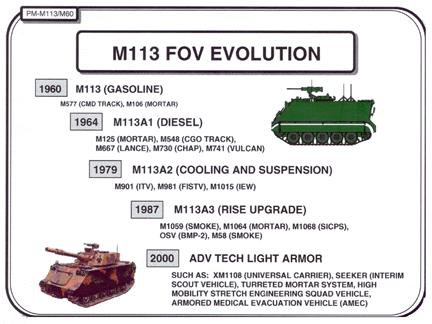
| [size=+2]Historical Evolution | ||||
| M113 | M113A1 | M113A2 | M113A3 | |
| Date Introduced | 1960 | 1964 | 1979 | 1987 |
| Curb Weight (lbs) | 20,310 | 21,474 | 21,608 | 23,575 |
| Combat Weight (lbs) | 23,520 | 24,594 | 24,728 | 27,000 |
| Top Speed (mph) | 37 | 37 | 37 | 41 |
| Cruising Range (miles) | 200 | 300 | ||
| Engine Type | Gasoline | Diesel | ||
| Engine HP | 209 | 212 | 275 | |
| HP/Ton | 17.8 | 17.2 | 17.1 | 20.4 |
| Acceleration (0-20 mph) sec | 12.0 | 10.5 | 11.0 | 7.8 |
| Turning Radius (in) | 276 | 168 | Pivot | |
| Trench Crossing (in) | 66 | |||
| Slope (%) | 60 | |||
| Side Slope (%) | 30 | |||
| Braking (ft) | 40 | 27 | ||
| Ground Pressure (psi) | 7.5 | 7.8 | 7.9 | 8.6 |
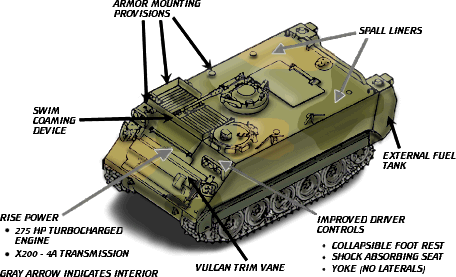

General | |
| Length | 191.5" |
| Width | 105.75" |
| Height | 86.5" |
| Clearance | 16" |
| Weight, combat loaded | 27,180 lb. (12,329 kg) |
| Maximum weight | 31,000 lb. (14,061 kg) |
| Net weight | 23,880 lb. (10,832 kg) |
| Air drop weight | 22,128 lb. (10,037 kg) |
| Personnel capacity | 2 + 11 |
| Fuel tank capacity | 95 gallons (360 liters) |
| Ground pressure | 8.63 psi (0.60 kg/cm2) |
Performance | |
| Speed on land | 41 mi/h (66 km/h) |
| Speed in water, with track | 3.6 mi/h (5.8 km/h) |
| Cruising range | 300 mi (483 km) |
| Turning radius | Pivot to infinite |
| Slope | 60% |
| Side slope | 40% |
| Trench crossing | 66 in. (168 cm) |
| Vertical wall climbing | 24 in. (61 cm) |
| Braking (20-0 mi/h) | 40 ft. |
Engine | |
| Make and model | Detroit Diesel 6V53T |
| Displacement | 318 in.3 (5.2 liter) |
| Fuel | Diesel (DF2) |
| Rated horsepower | 275 hp |
| Gross horsepower-to-weight ratio | 20.2 hp/ton |
Transmission, Automatic | |
| Make and model | Allison X200-4B |
| Type | Hydrokinetic |
| Steering | Hydrostatic |
| Brake type | Multiple wet plate |
Running Gear | |
| Suspension | Torsion bar |
| Road wheels | 5 per side, 24 inch diameter (61 cm) |
| Track type | Steel single pin, detachable rubber pad |
| Number of shoes | 63 left, 64 right |
| Track pitch | 6 in. (15.2 cm) |
| Track width | 15 in. (38 cm) |
| Shock absorbers | 3 per side |
| Wheel travel | 9.0 in. (22.9 cm) |
Electrical System | |
| Generator | |
| Amperes | 200, 300 optional |
| Volts, dc | 28 |
| Batteries | 4, type 6TL, 120 amp-hr, 12-volt each |
Armament | |
| 50 cal MG | 2,000 ready rds. |
Armor | |
| Basic hull | 5083 Aluminum |
| Bolt-on armor kit | Steel armor |
| Mine armor | Steel armor |
| Gun shield kit | Steel armor |
| Spall suppressant | Composite panel |
Fire Extinguishers | |
| Fixed | 5 lb. (2.3 kg) CO2 for engine compartment |
| Portable | 5 lb. (2.3 kg) CO2 |

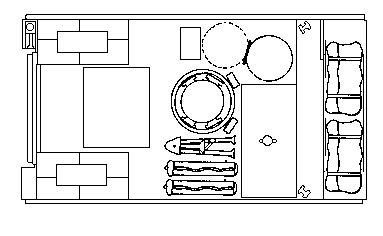
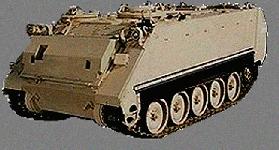

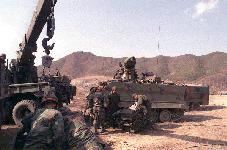
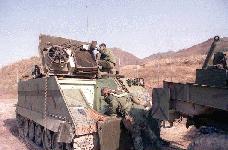
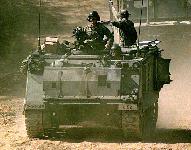
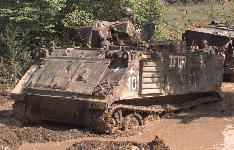

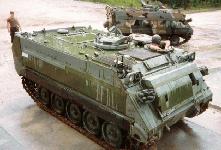
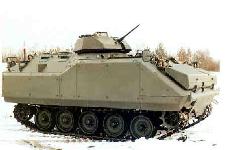
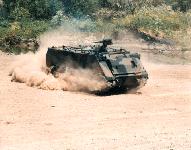
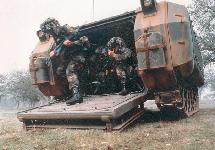
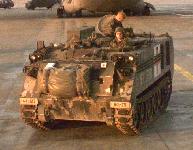
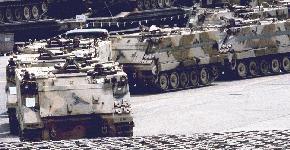
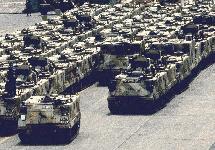
 The M113A3+ ESV is the only affordable solution that meets the Combat Engineer Squad requirements to transport an eight man engineer squad and all of their equipment while providing mobility and survivability equal to the maneuver force. The M113A3+ ESV supports the Engineer Squad in the performance of both offensive and defensive obstacle/counter-obstacle operations in support of the maneuver force. The vehicle can be adapted to fulfill other engineer mission objectives including: carrying the Volcano mine dispenser, the pathfinder marking system, and towing the MICLC trailer. Convertible for excess M113 assets, its basic configuration provides:
The M113A3+ ESV is the only affordable solution that meets the Combat Engineer Squad requirements to transport an eight man engineer squad and all of their equipment while providing mobility and survivability equal to the maneuver force. The M113A3+ ESV supports the Engineer Squad in the performance of both offensive and defensive obstacle/counter-obstacle operations in support of the maneuver force. The vehicle can be adapted to fulfill other engineer mission objectives including: carrying the Volcano mine dispenser, the pathfinder marking system, and towing the MICLC trailer. Convertible for excess M113 assets, its basic configuration provides:  As M113 FOV carriers become excess in the military system a number of conversion options are being considered for asset utilization. United Defense L.P., working with NASA/AMES, has developed the Hazardous Materials Recovery Vehicle (HAZMAT), as one such use for these excess assets. The HAZMAT vehicle utilizes a Stretch M577A3 hull structure incorporating a light dozer blade and a hydraulic manipulator arm. The vehicle provides a versatile chassis for hazardous material recovery operations. The HAZMAT has been designed to retain the air transportability features of the M113 FOV, with C-139 roll-on/roll-off capability. In addition the HAZMAT is being designed to include an over-pressure closed circuit life support system, radiation shielding, a HAZMAT suit docking feature, and a high visibility chemical agent resistant finish. The HAZMAT retains the M113 FOV mobility characteristics to support recovery operations in all terrains.
As M113 FOV carriers become excess in the military system a number of conversion options are being considered for asset utilization. United Defense L.P., working with NASA/AMES, has developed the Hazardous Materials Recovery Vehicle (HAZMAT), as one such use for these excess assets. The HAZMAT vehicle utilizes a Stretch M577A3 hull structure incorporating a light dozer blade and a hydraulic manipulator arm. The vehicle provides a versatile chassis for hazardous material recovery operations. The HAZMAT has been designed to retain the air transportability features of the M113 FOV, with C-139 roll-on/roll-off capability. In addition the HAZMAT is being designed to include an over-pressure closed circuit life support system, radiation shielding, a HAZMAT suit docking feature, and a high visibility chemical agent resistant finish. The HAZMAT retains the M113 FOV mobility characteristics to support recovery operations in all terrains.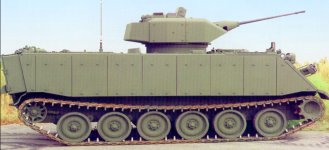 Infantry Fighting Vehicle Light (IFVL) is a light infantry fighting vehicle based on the proven MTVL chassis and featuring a one-man stabilized turret is convertible from existing assets or available as new production. It offers the exceptional automotive performance of the MTVL chassis combined with the substantial firepower of the stabilized 25mm chaingun and 7.62mm machinegun. The vehicle is powered by a 400hp 6V53TIA electronically controlled engine driving through the latest X200-4B cross drive transmission. The IFVL uses many common M113/MTVL components that help insure high reliability, availability, and maintainability, plus a proven design, common maintenance techniques and an established logistics infrastructure. Applique armor provides the flexibility to alter the armor package as the threat level changes or technology advances. The vehicle carries a crew of two or three and up to 10 dismount soldiers. As with all M113 variants,it is roll-on/roll-off transportable on a C130.
Infantry Fighting Vehicle Light (IFVL) is a light infantry fighting vehicle based on the proven MTVL chassis and featuring a one-man stabilized turret is convertible from existing assets or available as new production. It offers the exceptional automotive performance of the MTVL chassis combined with the substantial firepower of the stabilized 25mm chaingun and 7.62mm machinegun. The vehicle is powered by a 400hp 6V53TIA electronically controlled engine driving through the latest X200-4B cross drive transmission. The IFVL uses many common M113/MTVL components that help insure high reliability, availability, and maintainability, plus a proven design, common maintenance techniques and an established logistics infrastructure. Applique armor provides the flexibility to alter the armor package as the threat level changes or technology advances. The vehicle carries a crew of two or three and up to 10 dismount soldiers. As with all M113 variants,it is roll-on/roll-off transportable on a C130. 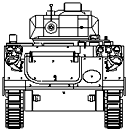
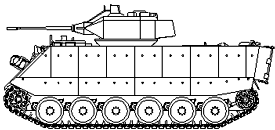
| 歡迎光臨 鐵之狂傲 (https://gamez.com.tw/) |